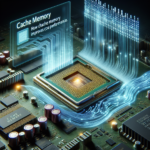How CPUs Handle Real-Time Financial Transactions
How CPUs Handle Real-Time Financial Transactions
In today’s fast-paced financial world, the ability to process transactions in real-time is crucial. From stock trading to online banking, the demand for instantaneous and secure financial transactions has never been higher. At the heart of this capability lies the Central Processing Unit (CPU), the brain of any computing system. This article delves into how CPUs handle real-time financial transactions, exploring the underlying technologies, challenges, and future trends.
Understanding Real-Time Financial Transactions
What Are Real-Time Financial Transactions?
Real-time financial transactions refer to the immediate processing and settlement of financial activities. Unlike traditional batch processing, where transactions are accumulated and processed at specific intervals, real-time processing ensures that each transaction is handled as soon as it is initiated. This is essential for activities such as stock trading, where market conditions can change in milliseconds, and for online banking, where users expect instant updates to their account balances.
Importance of Real-Time Processing
The importance of real-time processing in the financial sector cannot be overstated. It enhances customer satisfaction by providing immediate feedback, reduces the risk of fraud by quickly identifying suspicious activities, and improves overall operational efficiency. Moreover, in high-frequency trading, where algorithms execute thousands of trades per second, real-time processing is a necessity.
The Role of CPUs in Real-Time Financial Transactions
Basic CPU Functions
The CPU, or Central Processing Unit, is responsible for executing instructions from computer programs. It performs basic arithmetic, logic, control, and input/output (I/O) operations specified by the instructions. In the context of real-time financial transactions, the CPU’s role is to process transaction data swiftly and accurately.
Parallel Processing
One of the key techniques used by CPUs to handle real-time transactions is parallel processing. Modern CPUs are equipped with multiple cores, each capable of executing instructions independently. This allows for the simultaneous processing of multiple transactions, significantly reducing latency and increasing throughput.
Cache Memory
Cache memory is another critical component that enhances CPU performance. It is a small, high-speed memory located close to the CPU that stores frequently accessed data and instructions. By reducing the time needed to access data from the main memory, cache memory helps in speeding up transaction processing.
Instruction Pipelining
Instruction pipelining is a technique where multiple instruction phases are overlapped. Instead of waiting for one instruction to complete before starting the next, the CPU begins executing a new instruction before the previous one has finished. This increases the CPU’s instruction throughput, making it more efficient in handling real-time transactions.
Technologies Enabling Real-Time Processing
High-Frequency Trading (HFT) Systems
High-Frequency Trading (HFT) systems are designed to execute a large number of orders at extremely high speeds. These systems rely heavily on advanced CPUs with multiple cores and high clock speeds. Additionally, they use specialized hardware accelerators like Field-Programmable Gate Arrays (FPGAs) to further reduce latency.
In-Memory Computing
In-memory computing involves storing data in the main memory (RAM) rather than on traditional disk storage. This allows for much faster data retrieval and processing. CPUs in in-memory computing systems can access and process data almost instantaneously, making them ideal for real-time financial transactions.
Distributed Computing
Distributed computing involves a network of interconnected computers working together to process transactions. Each computer, or node, in the network handles a portion of the workload. This not only speeds up transaction processing but also provides redundancy and fault tolerance. CPUs in distributed systems are optimized for network communication and parallel processing.
Challenges in Real-Time Financial Transaction Processing
Latency
Latency is the time delay between the initiation and completion of a transaction. In real-time financial transactions, even a millisecond of delay can result in significant financial losses. Reducing latency involves optimizing both hardware and software components, including the CPU, memory, and network infrastructure.
Scalability
As the volume of financial transactions continues to grow, scalability becomes a critical concern. CPUs must be able to handle increasing workloads without compromising performance. This requires efficient load balancing, parallel processing, and the ability to add more computing resources as needed.
Security
Security is paramount in financial transactions. CPUs must be equipped with advanced security features to protect against threats such as hacking, data breaches, and fraud. This includes hardware-based security modules, encryption, and secure boot processes.
Future Trends in CPU Technology for Financial Transactions
Quantum Computing
Quantum computing holds the promise of revolutionizing real-time financial transaction processing. Unlike classical CPUs, which use bits to represent data, quantum computers use qubits that can represent multiple states simultaneously. This allows for exponentially faster data processing, making quantum computing ideal for complex financial algorithms and simulations.
Artificial Intelligence and Machine Learning
Artificial Intelligence (AI) and Machine Learning (ML) are increasingly being integrated into financial systems to enhance real-time transaction processing. CPUs optimized for AI and ML can analyze vast amounts of data in real-time, identify patterns, and make predictions. This can improve decision-making in areas such as fraud detection, risk management, and trading strategies.
Edge Computing
Edge computing involves processing data closer to its source rather than relying on centralized data centers. This reduces latency and bandwidth usage, making it ideal for real-time financial transactions. CPUs in edge computing devices are designed for low power consumption and high performance, enabling efficient transaction processing at the network’s edge.
FAQ
What is the role of the CPU in real-time financial transactions?
The CPU is responsible for executing instructions and processing transaction data swiftly and accurately. It uses techniques like parallel processing, cache memory, and instruction pipelining to handle multiple transactions simultaneously and reduce latency.
How does parallel processing improve transaction speed?
Parallel processing allows multiple CPU cores to execute instructions independently, enabling the simultaneous processing of multiple transactions. This significantly reduces latency and increases throughput, making it ideal for real-time financial transactions.
What are the challenges in real-time financial transaction processing?
The main challenges include latency, scalability, and security. Reducing latency involves optimizing both hardware and software components. Scalability requires efficient load balancing and the ability to add more computing resources. Security involves protecting against threats such as hacking, data breaches, and fraud.
How does in-memory computing benefit real-time financial transactions?
In-memory computing stores data in the main memory (RAM) rather than on traditional disk storage, allowing for much faster data retrieval and processing. This makes CPUs in in-memory computing systems ideal for real-time financial transactions.
What future trends are expected to impact CPU technology for financial transactions?
Future trends include quantum computing, which offers exponentially faster data processing; artificial intelligence and machine learning, which enhance decision-making; and edge computing, which reduces latency by processing data closer to its source.
Conclusion
CPUs play a pivotal role in handling real-time financial transactions, leveraging advanced technologies like parallel processing, cache memory, and instruction pipelining to meet the demands of modern financial systems. While challenges such as latency, scalability, and security persist, ongoing advancements in CPU technology, including quantum computing, AI, and edge computing, promise to further enhance the efficiency and reliability of real-time financial transaction processing. As the financial landscape continues to evolve, the importance of robust and efficient CPUs will only grow, ensuring that transactions are processed swiftly, securely, and accurately.




